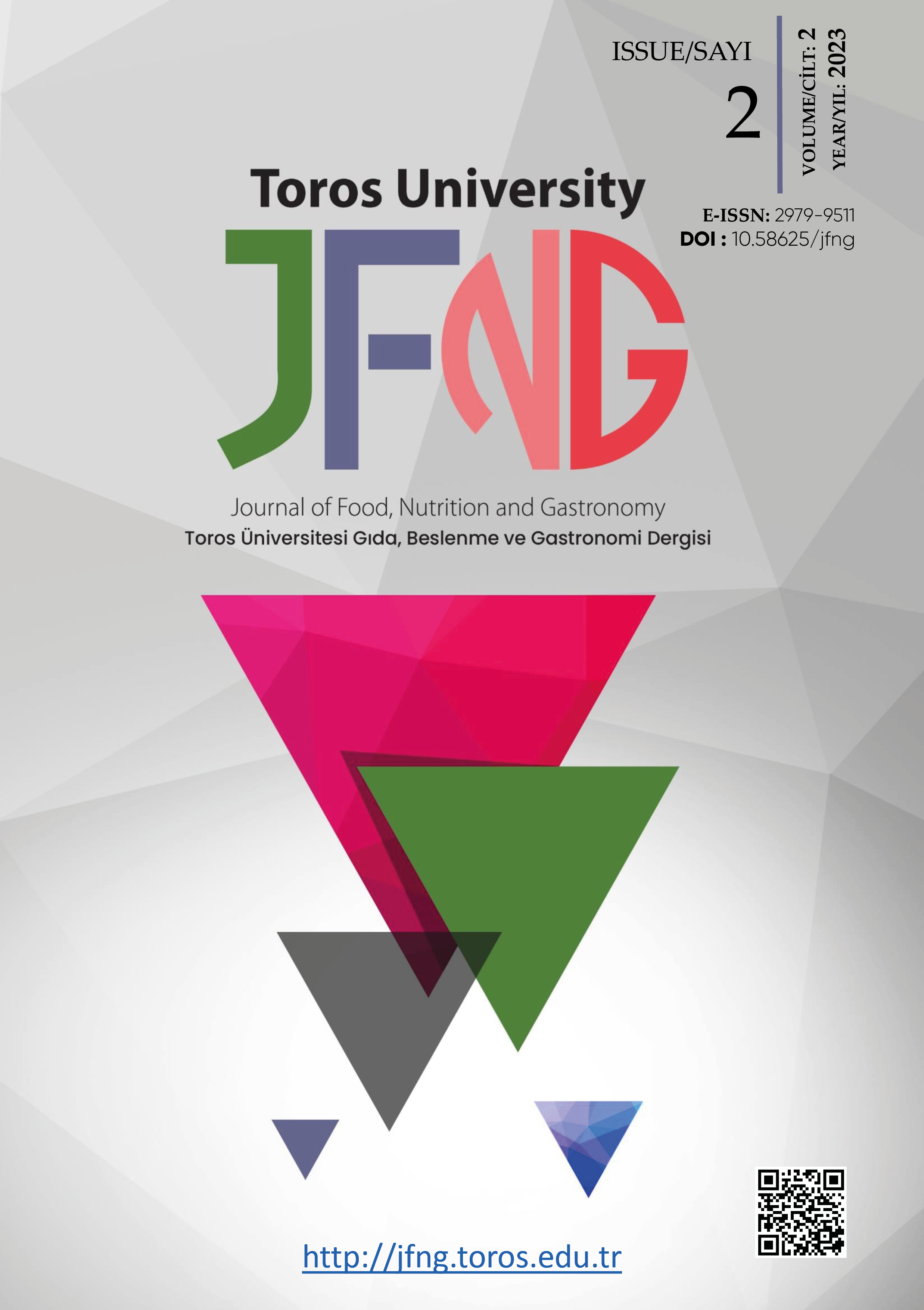Özet
İnsan sağlığına fayda sağlayabilecek lifler, mineraller ve polifenolikler açısından zengin olan ve besin kaynağı olarak yüksek potansiyele sahip olan keçiboynuzu pekmezi posası unu (CMP), keçiboynuzu pekmezi ve keçiboynuzu şurubu üretiminin bir atık veya yan ürünüdür. Bu çalışmada, besin değeri artırılmış ucuz gıda ürünleri geliştirmek amacıyla yaygın olarak tüketilen keklere endüstriyel gıda atığı CMP ilavesinin kekin dokusal, fiziksel ve duyusal niteliklerine etkisi araştırılmıştır. Bu çalışmada kekte buğday unu yerine %5, 10 ve 15 oranında CMP kullanılmış ve kekin kalite özellikleri araştırılmıştır. Kontrol kekinde ağırlık kaybı %14.50±0.1 ve hacim 101.83±0.7 dm3 olup tüm örneklerle benzerdi. Her ne kadar CMP15 kekinin sertliği (480.95±94.5 g) biraz artmış olsa da (p<0.05), CMP05 ve CMP10, kontrol kekiyle (368.75±33.4 g) benzer dokulara sahipti. En yüksek renk değerleri kontrol kekindeydi (L*=60.68±0.71 ve b*=45.79±0.47). Kek renkleri büyük ölçüde CMP'ye bağlıydı. CMP, bazı tüketiciler tarafından tercih edilen ve istenen kakao benzeri rengi arttırdı. Sonuç olarak, CMP kullanımı kek örneklerinin hacmini, ağırlık kaybını, dokusunu ve duyusal özelliklerini kontrole göre önemli ölçüde değiştirmedi. Elde edilen bulgulara göre, duyusal kabulü yüksek olan ve kalite parametrelerini düşürmeden kek tariflerine %15'e kadar CMP eklenebilmektedir. Sonuç olarak lifler, mineraller ve polifenolikler açısından son derece zengin olduğu düşünülen CMP'nin, fonksiyonel gıdalar gibi birçok gıda maddesi için doğal bir katkı maddesi veya ikame malzemesi olarak çok uygun olabileceği düşünülmektedir.
Referanslar
Altug Onogur, T., & Elmaci, Y. (2015). Sensory Evaluation on Foods. Sidas Publishing. 2nd ed., pp.135. İzmir, Türkiye.
Aydogdu, A., Sumnu, G. & Sahin, S. (2018). Effects of addition of different fibers on rheological characteristics of cake batter and quality of cakes. Journal of Food Science and Technology, 55, 667–677. https://doi.org/10.1007/s13197-017-2976-y.
Berk, E., Şumnu, S. G., Şahin, S. (2017). Effects of hydrocolloids and carob bean flour on rheological properties of batter and cake quality. Gıda, 42(6), 754- 762.
El-Beltagi, H. S., Ahmed, A. R., Mohamed, H. I., Al-Otaibi, H. H., Ramadan, K. M., & Elkatry, H. O. (2023). Utilization of prickly pear peels flour as a natural source of minerals, dietary fiber, and antioxidants: effect on cakes production. Agronomy, 13(2), 439.https://doi.org/10.3390/agronomy13020439.
Fennema, O.R. (1996). Food Chemistry (3rd ed.). New York, Marcel Dekker
Fidan, H.; Petkova, N.; Sapundzhieva, T.; Baeva, M.; Goranova, Z.; Slavov, A.; & Krastev, L. Carob syrup and carob flour (Ceratonia siliqua L.) as functional ingredients in sponge cakes. (2019). Carpathian Journal of Food Science and Technology, 11, 71–82.
Grigelmo-Miguel & Martin-Belloso, (1999). Comparison of dietary fibre from by-products of processing fruits and greens and from cereals. LWT-Food Science and Technology, 32, 503- 508.
Haber, B., (2002). Carob fibre benefits and applications. Cereal Foods World, 47, 365-369.
Hosseini, A., & Pazhouhandeh, F. (2023). Production of enriched cakes by apple pulp and peel powder and evaluation of chemical, functional and textural properties. Vitae, 30(1). https://doi.org/10.17533/udea.vitae.v30n1a349519.
İlhan, S., (2013). Production of Bakery Products Added Carob. Unpublished master's thesis. pp. 81. Mersin University, Mersin, Türkiye.
Nakov, G., Brandolini, A., Hidalgo, A., Ivanova, N., Stamatovska, V., & Dimov, I.K. (2020). Effect of grape pomace powder addition on chemical, nutritional and technological properties of cakes. LWT-Food Science and Technology. 134, 109950. DOI: 10.1016/j.lwt.2020.109950
Owen, RW, Haubner, R, Hull, WE, Erben, G, Spiegelhalder, B, Bartsch, H & Haber, B (2003). Isolation and structure elucidation of the major individual polyphenols in carob fibre. Food Chemical Toxicology, 41, 1727–1738.
Ozdemir, Y., Oncel, B. & Keceli, M. (2021). Purification of crude fiber from carob molasses pulp and uses in traditional Turkish sucuk. International Journal of Gastronomy and Food Science, 25, 1-5. https://doi.org/10.1016/j.ijgfs.2021.100410.
Ozdemir, Y., Ozbek, C. & Ilhan, S. (2022). Ice cream cone enriched with carob molasses pulp. Food Measure 16, 3782–3791. https://doi.org/10.1007/s11694-022-01489-w.
Papageorgiou, M., Paraskevopoulou, A., Pantazi, F. & Skendi, A., (2020). Cake perception, texture and aroma profile as affected by wheat flour and cocoa replacement with carob flour. Foods, 9(11), 1586. doi: 10.3390/foods9111586.
Purlis, E. (2010). Browning development in bakery products–A review. Journal of Food Engineering, 99(3), 239-249.
Rosa, C.S., Tessele, K., Prestes, R.C., Silveira, M. & Franco, F., (2015). Effect of substituting of cocoa powder for carob flour in cakes made with soy and banana flours. International Food Research Journal, 22, 2111–2118.
Serin, S., & Sayar, S. (2017). The effect of the replacement of fat with carbohydrate-based fat replacers on the dough properties and quality of the baked pogaca: a traditional high-fat bakery product. Food Science Technology (Campinas), 37 (1):25-32. https://doi.org/10.1590/1678-457X.05516
Sharoba, A., Farrag, M., & Abd El-Salam, A. (2013). Utılızatıon of some fruıts and vegetables wastes as a source of dıetary fıbers ın cake makıng. Journal of Food and Dairy Sciences, 4(9), 433-453. doi: 10.21608/jfds.2013.72084.
Xiao, J., Li, Y., Niu, L., Chen, R., Tang, J., Tong, Z., & Xiao, C. (2023). Effect of Adding Fermented Proso Millet Bran Dietary Fiber on Micro-Structural, Physicochemical, and Digestive Properties of Gluten-Free Proso Millet-Based Dough and Cake. Foods, 12(15), 2964.https://doi.org/ 10.3390/foods12152964.
Yalım Kaya, S. & Özdemir, Y. (2015). Effect of extraction conditions and water holding capacity of fruit on soluble solid extraction from carob pod. Gıda, 40(6): 327 – 334. DOI:10.15237/gida.GD15022.

Bu çalışma Creative Commons Attribution 4.0 International License ile lisanslanmıştır.
Telif Hakkı (c) 2024 Toros Üniversitesi Gıda, Beslenme ve Gastronomi Dergisi






